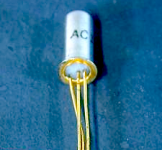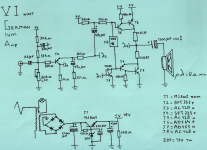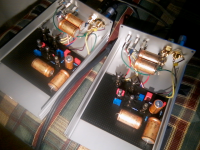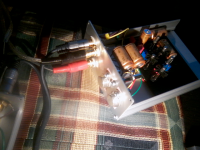A small question,
I recently build a small fully Germanium transistor amp.
But yesterday the strangest thing happened to the Left mono block.
It started to make a deep brown noise and sputter.
So i started to wiggle all the transistors (they are socketed) but no result.
Finaly i touched the VAS transistor with my finger and the speaker started
to hum. (this should be possible since it's fully isolated from the can)
So i tested this on the other amp -- but it stayed quiet.
I measured the quiescent current and the voltage at the output but remarkably
this stayed fairly stable, No sound was coming from the speaker though.
finally when i warmed the transistor up or cooled it down with my finger it slowly started to make brown noise again and some music.
Off course i changed to faulty device and the amp works fine now.
But I want to ask everybody:
What are the typical types/kinds of failures you guy's have seen in germanium transistors.
I find this behavior strange.
I am used to silicon transistors either shorting out or staying open at one or more junctions.
but never this almost faulty tube like behavior.
I could literally steer this behavior by tapping or touching the transistor.
Thanks in advance, Pim
I recently build a small fully Germanium transistor amp.
But yesterday the strangest thing happened to the Left mono block.
It started to make a deep brown noise and sputter.
So i started to wiggle all the transistors (they are socketed) but no result.
Finaly i touched the VAS transistor with my finger and the speaker started
to hum. (this should be possible since it's fully isolated from the can)
So i tested this on the other amp -- but it stayed quiet.
I measured the quiescent current and the voltage at the output but remarkably
this stayed fairly stable, No sound was coming from the speaker though.
finally when i warmed the transistor up or cooled it down with my finger it slowly started to make brown noise again and some music.
Off course i changed to faulty device and the amp works fine now.
But I want to ask everybody:
What are the typical types/kinds of failures you guy's have seen in germanium transistors.
I find this behavior strange.
I am used to silicon transistors either shorting out or staying open at one or more junctions.
but never this almost faulty tube like behavior.
I could literally steer this behavior by tapping or touching the transistor.
Thanks in advance, Pim
Hi Pim,
In the past, I found that some Germanium transistor would produce random noise also.
The OC series was very bad for this and if the Black paint was remove they do become sensitive to light. The case you describe make me think you are using AD series, in power supplies I found these particle bad for 5-10KHz parasitic oscillation, and often took weeks to become active.
Mullard books circa 1975 have many good article about this in them try and find a copy.
I have a few so I will dig them out and copy and paste info.
Best Col
In the past, I found that some Germanium transistor would produce random noise also.
The OC series was very bad for this and if the Black paint was remove they do become sensitive to light. The case you describe make me think you are using AD series, in power supplies I found these particle bad for 5-10KHz parasitic oscillation, and often took weeks to become active.
Mullard books circa 1975 have many good article about this in them try and find a copy.
I have a few so I will dig them out and copy and paste info.
Best Col
Some type of Ge transistors in metal case were prone to case/electrode shorts due to whiskers growth. That could be the case hereA small question,
I recently build a small fully Germanium transistor amp.
But yesterday the strangest thing happened to the Left mono block.
It started to make a deep brown noise and sputter.
So i started to wiggle all the transistors (they are socketed) but no result.
Finaly i touched the VAS transistor with my finger and the speaker started
to hum. (this should be possible since it's fully isolated from the can)
So i tested this on the other amp -- but it stayed quiet.
I measured the quiescent current and the voltage at the output but remarkably
this stayed fairly stable, No sound was coming from the speaker though.
finally when i warmed the transistor up or cooled it down with my finger it slowly started to make brown noise again and some music.
Off course i changed to faulty device and the amp works fine now.
But I want to ask everybody:
What are the typical types/kinds of failures you guy's have seen in germanium transistors.
I find this behavior strange.
I am used to silicon transistors either shorting out or staying open at one or more junctions.
but never this almost faulty tube like behavior.
I could literally steer this behavior by tapping or touching the transistor.
Thanks in advance, Pim
I agree with Elvee and was going to post exactly the same - namely old GE transistors are at risk of growing crystals which can lead to all sorts of odd behavior.
I have rennovated a Germaniun transistor based Leak Stereo 30 (not the 30 plus) and discovered a similar problem during doing so. The Stereo 30 works fine, now, and credits modern sources such as CD wonderfully. Touch wood - all the original electrolytic capacitors are somehow still doing what they say on the tin!!
I have rennovated a Germaniun transistor based Leak Stereo 30 (not the 30 plus) and discovered a similar problem during doing so. The Stereo 30 works fine, now, and credits modern sources such as CD wonderfully. Touch wood - all the original electrolytic capacitors are somehow still doing what they say on the tin!!
Quite a good page on this issue here,
Anecdote: Tin Whiskers Inside of AF114 Transistors
Anecdote: Tin Whiskers Inside of AF114 Transistors
Thanks for the replies guys.
i knew about the whisker problem in germanium transistors, but the fact is that the transistor i was talking about is a AC187 bullet type filled with some resin or epoxy with the leads sticking out. (see the picture)
So the chance of growing whiskers seems small (not impossible).
I can also imagine that the complete setup of germanium and leads is completely covered with resin so contact with the metal shell should actually be impossible and the case should be completely isolated.
I would certainly like to learn more about those parasitic oscillations occurring in some transistors.
So ROOT2 / Col--> if you ever come across that article then i would love to read it.
but i wont dismiss the whisker problem so easily (maybe i'll open it up)
I have a few very strong Leica microscopes at work.
they also have a camera so if i can take pictures i will, and post them!
Thanks again
i knew about the whisker problem in germanium transistors, but the fact is that the transistor i was talking about is a AC187 bullet type filled with some resin or epoxy with the leads sticking out. (see the picture)
So the chance of growing whiskers seems small (not impossible).
I can also imagine that the complete setup of germanium and leads is completely covered with resin so contact with the metal shell should actually be impossible and the case should be completely isolated.
I would certainly like to learn more about those parasitic oscillations occurring in some transistors.
So ROOT2 / Col--> if you ever come across that article then i would love to read it.
but i wont dismiss the whisker problem so easily (maybe i'll open it up)
I have a few very strong Leica microscopes at work.
they also have a camera so if i can take pictures i will, and post them!
Thanks again
Attachments
The case is filled with a silicone compound (silicone oil mixed with a mineral load), not resin. I don't think it would be an obstacle to the growth of whiskersThanks for the replies guys.
i knew about the whisker problem in germanium transistors, but the fact is that the transistor i was talking about is a AC187 bullet type filled with some resin or epoxy with the leads sticking out. (see the picture)
So the chance of growing whiskers seems small (not impossible).
The case is filled with a silicone compound (silicone oil mixed with a mineral load), not resin. I don't think it would be an obstacle to the growth of whiskers
I've read the article on the growth of whiskers and i must say it's a scary thought that many transistors from this era have these tendencies
 .
.I better start searching for replacements or it will be more like
 very soon.
very soon.Maybe i am lucky and it stays working with the replacement or it is just slowly aging to its doom
 even when the amp is brand new.
even when the amp is brand new.Well again the transistors are socketed so replacing (even with silicon types) will be very easy -- just a little adjustment and its ready to go again.
I just hope this was just a random faulty transistor and not one that was plagued by this whisker phenomenon. They tend to short out from the whiskers and this one only partially lost its function. So there is hope!
Included some pictures and the circuit (AC128 should be AC187)
Thanks
Attachments
I've read the article on the growth of whiskers and i must say it's a scary thought that many transistors from this era have these tendencies.
I better start searching for replacements or it will be more likevery soon.
Maybe i am lucky and it stays working with the replacement or it is just slowly aging to its doomeven when the amp is brand new.
Well again the transistors are socketed so replacing (even with silicon types) will be very easy -- just a little adjustment and its ready to go again.
I just hope this was just a random faulty transistor and not one that was plagued by this whisker phenomenon. They tend to short out from the whiskers and this one only partially lost its function. So there is hope!
Included some pictures and the circuit (AC128 should be AC187)
Thanks
Hi Capt,
I have a few Ge transistors if you are stuck.
Col
I'm just curious as to why one would bother with germanium devices? I have never personally used them, but based on what I know about them I'm not sure why one would.
Do they have a particular sound? Is it just for the challenge? Is there some advantage you were after despite germanium's caveats?
Do they have a particular sound? Is it just for the challenge? Is there some advantage you were after despite germanium's caveats?
I'm just curious as to why one would bother with germanium devices? I have never personally used them, but based on what I know about them I'm not sure why one would.
Do they have a particular sound? Is it just for the challenge? Is there some advantage you were after despite germanium's caveats?
You could argue the same about valve amplifiers! The idea that just because somethings old, its no longer viable is popular but wrong. A lot of people might buy a brand spanking new amplifier to "keep up with the Joneses" and throw away what might be a perfectly good piece of equipment after some TLC. AS I've said, there is nothing wrong with a Ge amplifier over a Si amplifier of similar age, apart from slightly more noisy, but most cases perfectly listenable and acceptable especially if you ignore "specmanship". I play CD through a Leak Stereo 30 I've renovated and it sounds no less limited than any other amplifier from the 60s/70s although it maybe does not have quite the same nostalgic appeal as a fully glowing valve amplifier of course.
Last edited:
This project was actually born out of boredom in the holiday season.
And the fact that i had many Ge devices laying around.
At first I experimented with a germanium transistor as a current source (half biased transistor) for a small light bulb merely to observe Ge behavior with temperature shifts and frequency.
Keep in mind that i am 25 years old and experimenting with these devices is just out of curiosity and the sense of nostalgia.
I actually found out that these devices are fairly unstable in nature when it comes to temperature. I could actually slightly influence the lightbulbs brightness by cooling the transistor down with my fingers.
Then i started matching / selecting them for highest and matching β. So that left me with a stunning 14 (npn/pnp) out of the nearly 40 transistors (the rest was slightly to vastly under-performing) and then i realized that the minimal number of transistors to build a decent amplifier is 5 transistors per channel (Singleton, VAS, VBE, Drivers) --- So yes, there the idea was born and two or three days later i had drawn this very basic circuit, made a test build from the drop-out group, and finished the final builds all with new parts in my parts inventory so nothing new was bought for this project.
Conclusion: it was just for fun
P.S. and for the sound, well lets just say I am very surprised and find it very hard to notice any difference with a modern Chip-Amp for example.
The only thing is the dampening factor seems to be fairly low (partially to blame on the 20w power supply) and this contributes to a slightly over exaggerated low end on some speaker systems. The fact that there is no tone, pre-amp and volume control may add to its clarity. As for the difference between Ge and Si, aside from noise and temperature related tonal attributes maybe? --- well --- nothing i guess.
Pim
And the fact that i had many Ge devices laying around.
At first I experimented with a germanium transistor as a current source (half biased transistor) for a small light bulb merely to observe Ge behavior with temperature shifts and frequency.
Keep in mind that i am 25 years old and experimenting with these devices is just out of curiosity and the sense of nostalgia.
I actually found out that these devices are fairly unstable in nature when it comes to temperature. I could actually slightly influence the lightbulbs brightness by cooling the transistor down with my fingers.
Then i started matching / selecting them for highest and matching β. So that left me with a stunning 14 (npn/pnp) out of the nearly 40 transistors (the rest was slightly to vastly under-performing) and then i realized that the minimal number of transistors to build a decent amplifier is 5 transistors per channel (Singleton, VAS, VBE, Drivers) --- So yes, there the idea was born and two or three days later i had drawn this very basic circuit, made a test build from the drop-out group, and finished the final builds all with new parts in my parts inventory so nothing new was bought for this project.
Conclusion: it was just for fun
P.S. and for the sound, well lets just say I am very surprised and find it very hard to notice any difference with a modern Chip-Amp for example.
The only thing is the dampening factor seems to be fairly low (partially to blame on the 20w power supply) and this contributes to a slightly over exaggerated low end on some speaker systems. The fact that there is no tone, pre-amp and volume control may add to its clarity. As for the difference between Ge and Si, aside from noise and temperature related tonal attributes maybe? --- well --- nothing i guess.
Pim
Very interesting report and pics.Quite a good page on this issue here,
Anecdote: Tin Whiskers Inside of AF114 Transistors
I have read anywhere, that an additional unwanted effect is the chemical variation of the potting compounds (isolation character like plastic in new condition and an unwanted semiconductor character with increasing aging process).
I can't say it was always the case, but the silicone grease used was a popular new substance in the 1950-60s and it was used everywhere in pharmaceuticals, industrial lubricants, chemical labs and aerospace because it was translucent, high purity and inert to chemical attack and high voltage with excellent dielectric properties....an additional unwanted effect is the chemical variation of the potting compounds.....
The general composition was simple, being a blend of Silicone oils and a microfine silica (SiO2) aerogel. That's a notoriously hazardous material to breathe, but like asbestos, is relatively benign in a wetted state. I know, because I used to formulate the stuff in various grades for laboratory ware, protective creams and electrical insulation that are still required.
I think that to keep the power ratings of the silicone-sealed transistors, you would have to retain this grease if you disassembled and removed the whiskers in an attempt to rejuvenate a "whiskered transistor". It needs to be resealed somehow to prevent corrosion anyway.
It also occurs to me that it should be possible to passivate clean tin plated surfaces (case inner surface and most of the leads) with dichromate solution, perhaps as done industrially to preseve some raw plated metal surfaces. I don't know that it will be effective, as I haven't tried it but for those wanting to make old, unobtanium parts last indefinitely, it may be well worth the effort to find out what inhibits whiskering
- Status
- This old topic is closed. If you want to reopen this topic, contact a moderator using the "Report Post" button.
- Home
- Amplifiers
- Solid State
- Germanium transistor madness



